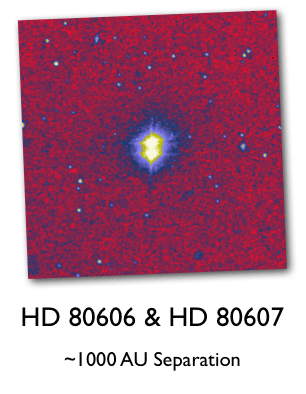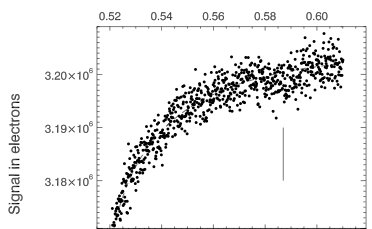
Image Source.
Another long gap between posts. I’m starting to dig out from under my stack, however, and there’ll soon be some very interesting items to report.
As mentioned briefly in the previous post, our Spitzer observations of HD 80606 did indeed occur as scheduled. Approximately 7,800 8-micron 256×256 px IRAC images of the field containing HD 80606 and its binary companion HD 80607 were obtained during the 30-hour interval surrounding the periastron passage. On Nov. 22nd, the data (totaling a staggering 6 GB) was down-linked to the waiting Earth-based radio telescopes of NASA’s Deep Space Network. By Dec 4th, the data had cleared the Spitzer Science Center’s internal pipeline.

We’re living in a remarkable age. When I was in high school, I specifically remember standing out the backyard in the winter, scrutinizing the relatively sparse fields of stars in Ursa Major with my new 20×80 binoculars, and wondering whether any of them had planets. Now, a quarter century on, it’s possible to write and electronically submit a planetary observation proposal on a laptop computer, and then, less than a year later, 6 GB of data from a planet orbiting one of the stars visible in my binoculars literally rains down from the sky.
It will likely take a month or so before we’re finished with the analysis and the interpretation of the data. The IRAC instrument produces a gradually increasing sensitivity with time (known to the cognescenti as “the ramp”). This leads to a raw photometric light curve that slopes upward during the first hours of observation. For example, here’s the raw photometry from our Gliese 436 observations that Spitzer made last Summer. The ramp dominates the time series (although the secondary eclipse can also be seen):

The ramp differs in height, shape, and duration from case to case, but it is a well understood instrumental effect, and so its presence can be modeled out. Drake Deming is a world expert on this procedure, and so the data is in very capable hands. Once the ramp is gone, we’ll have a 2800-point 30 hour time series for both HD 80606 and HD 80607. We’ll be able to immediately see whether a secondary transit occurred (1 in 6.66 chance), and with more work, we’ll be able to measure how fast the atmosphere heats up during the periastron passage. Jonathan Langton is running a set of hydrodynamical simulations with different optical and infrared opacities, and we’ll be able to use these to get a full interpretation of the light curve.
In another exciting development, Joe Lazio, Paul Shankland, David Blank and collaborators were able to successfully observe HD 80606 using the VLA during the Nov. 19-20 periastron encounter! It’s not hard to imagine that there might be very interesting aurora-like effects that occur during the planet’s harrowing periastron passage. If so, the planet might have broadcasted significant power on the decameter band. Rest assured that when that when their analysis is ready, we’ll have all the details here at oklo.org.

The radio detection of extrasolar planets is an area I’m very interested in: as I understand it, this is one of the best possibilities for finding out rotation periods of exoplanets, and could also potentially reveal analogues of the Io-Jupiter system, thus possibly giving a detection of “exo-moons”.
Hi all!
some exciting news on HD17156b too.
The Subaru team measured the Rossiter-McLaughlin effect for this one. Significant deviation from 0 degree orientation was measured!
Moreover, HD17156 was added as one of the targets of the extended Deep Impact, EPOXI, mission.
Finally, it seems the planet has a huge metal core, given the very high density of 2.5g/cm3.
This is quite a an interesting beast !
Cheers,
Luis
Hi Luis,
Thanks for the update. The Subaru team’s RM paper is quite interesting and tantalizing… It’ll be interesting to see whether the non-alignment of the orbital plane and the stellar spin axis can be confirmed.
best,
Greg
Another new bit of excitement: COROT put out a press release today. They announced one extrasolar planet, a 3.5 Jupiter mass transiting planet in an under 2 day orbit around a sun-like star. They also mention “many light curves” showing probably transits that are still waiting for radial velocity followup.
Hi tfisher98,
Indeed that’s interesting! This second corot planet is a great one for transit timing…
best,
Greg
About measuring the rotation period of planets… There are some other promising methods, too. If you’re interested, see “On constraining a transiting exoplanet’s rotation rate with its transit spectrum” (http://arxiv.org/abs/0705.0004) or “Identifying the Rotation Rate and the Presence of Dynamic Weather on Extrasolar Earth-Like Planets from Photometric Observations” (http://www.journals.uchicago.edu/doi/pdf/10.1086/528677)